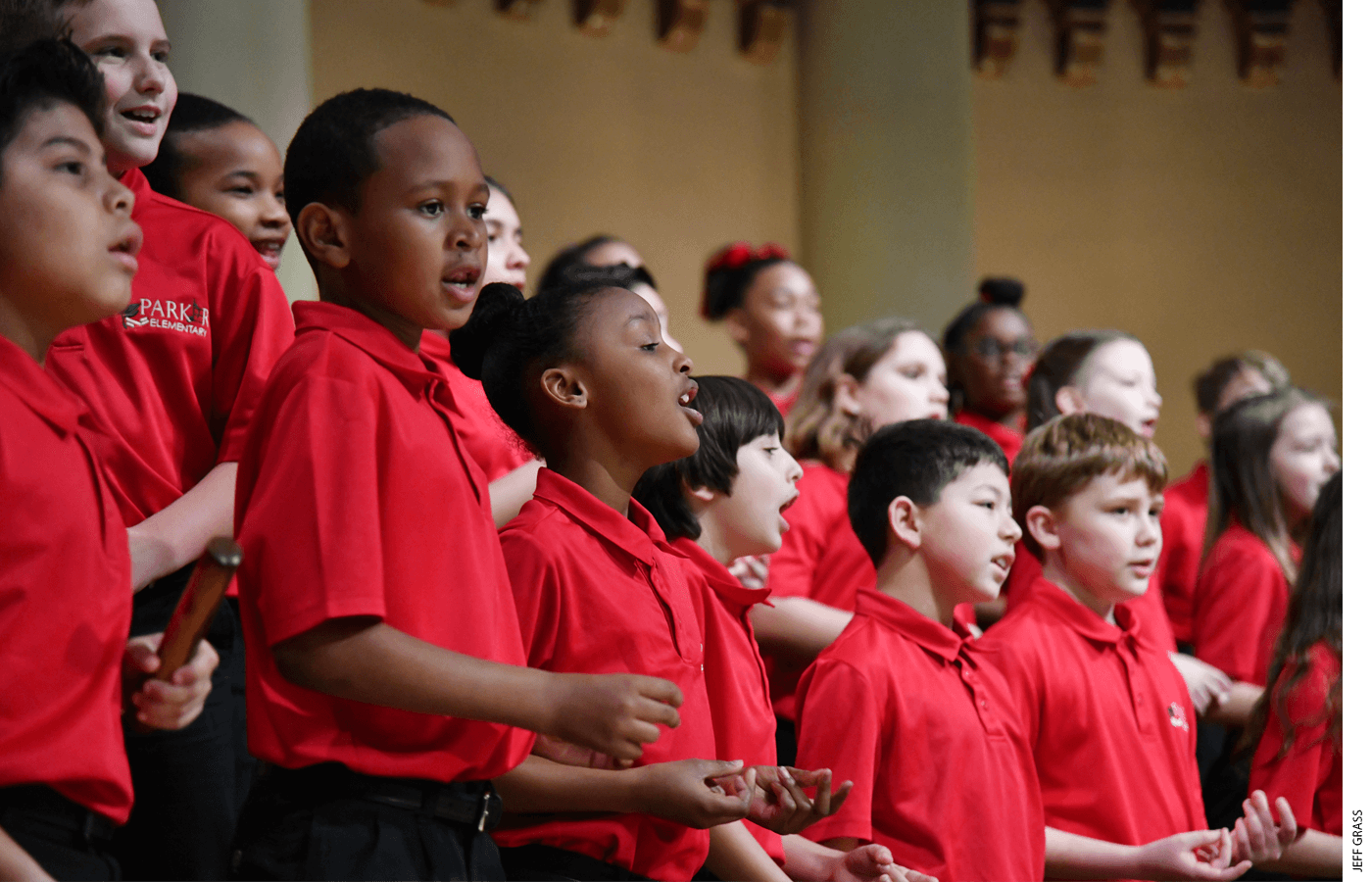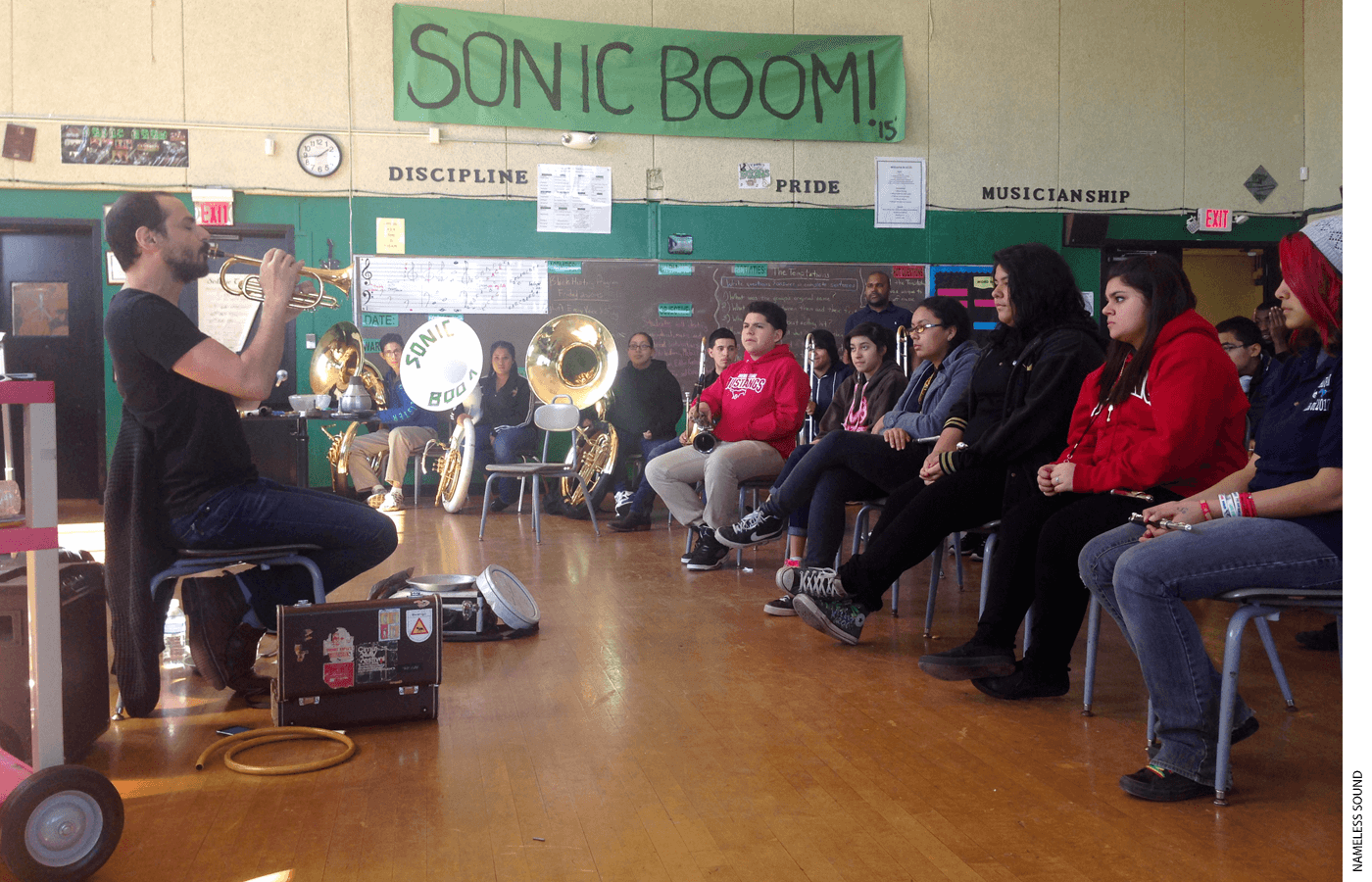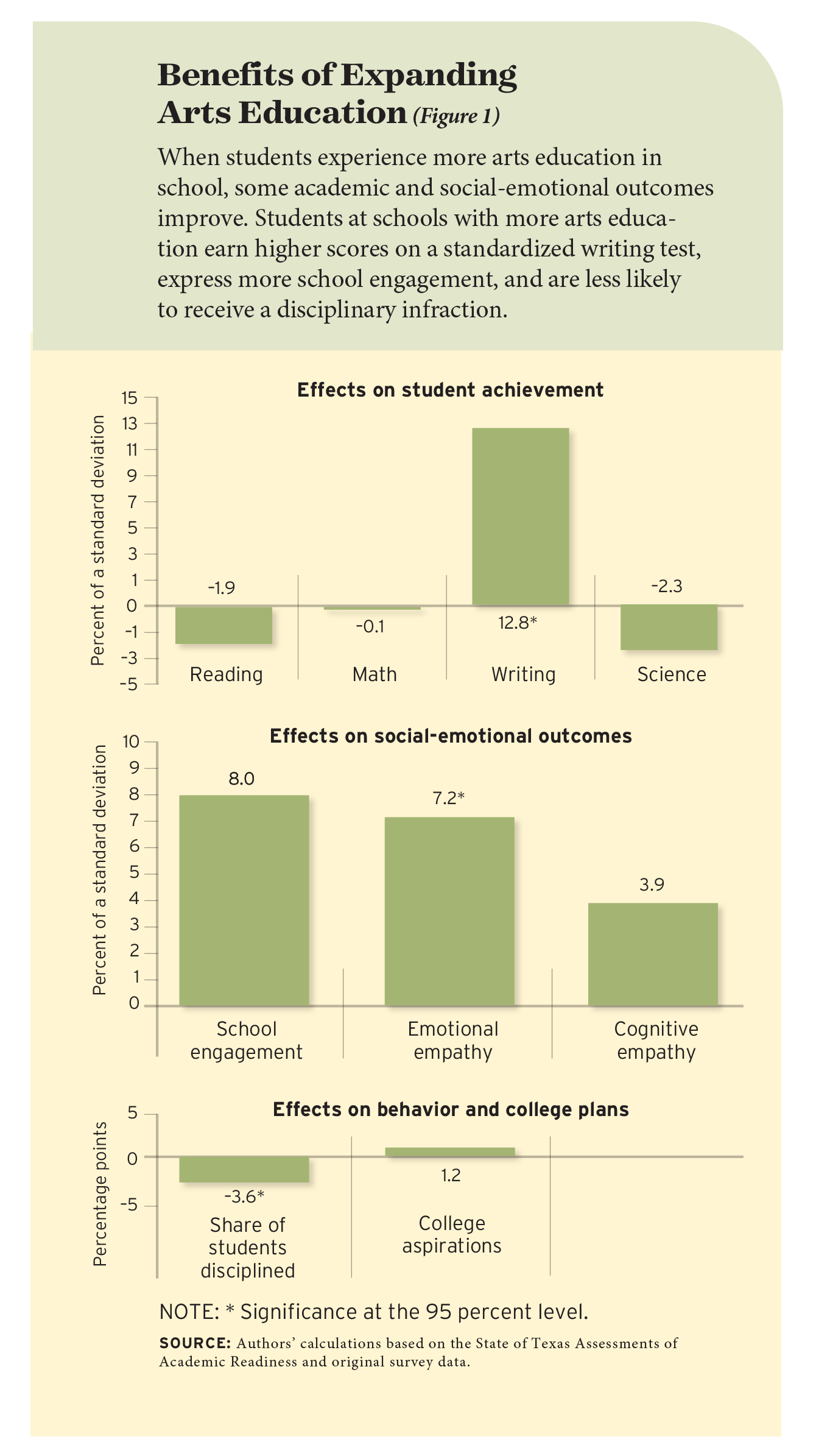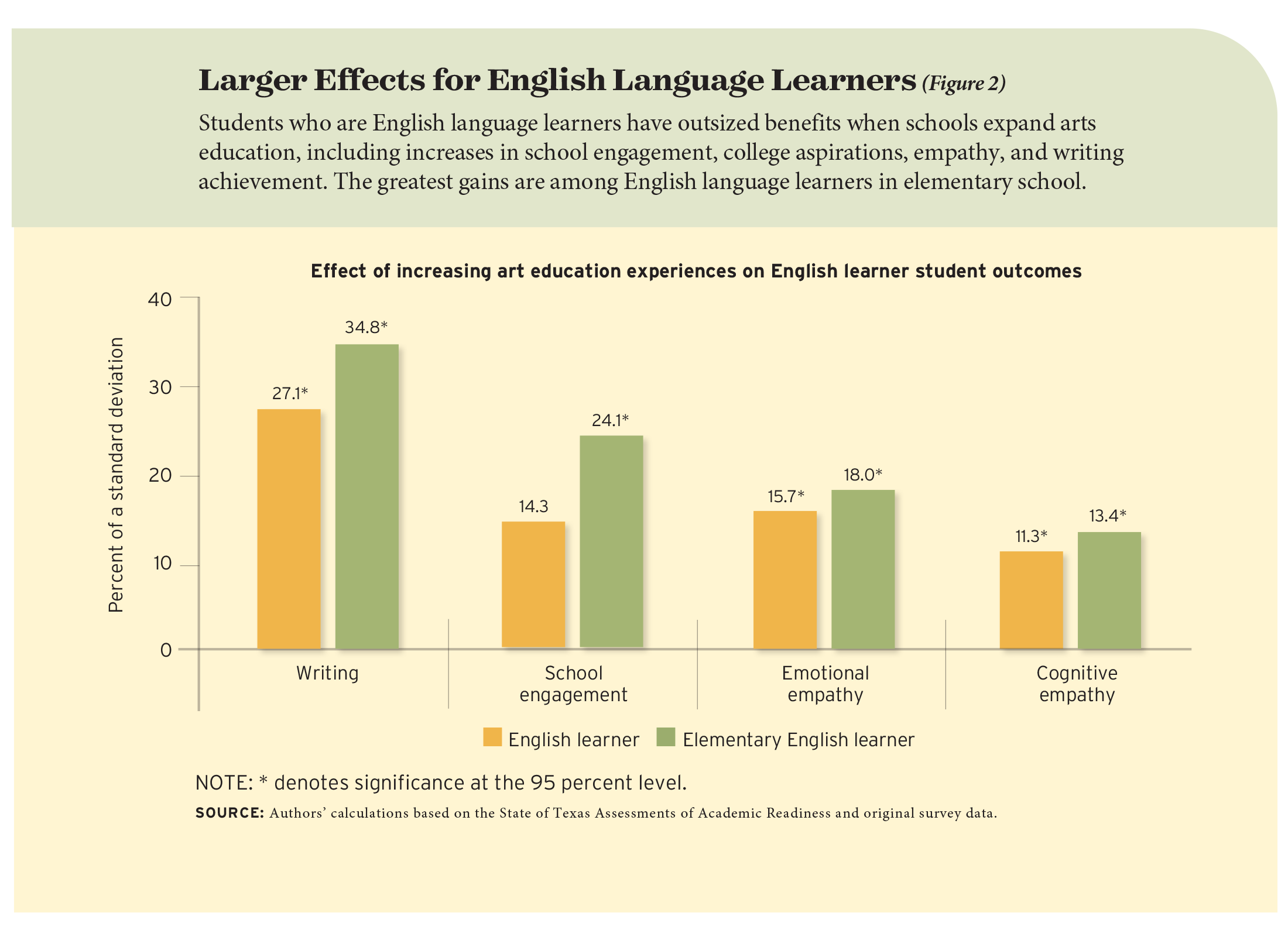
From their earliest years, children use art for learning and self-expression. Preschoolers draw, paint, and build to understand and depict their surroundings. They learn their letters by singing the alphabet song. And they immerse themselves in stories to learn about their natural and social worlds, from books read by caregivers and during dress-up and imaginative play.
Yet the arts maintain a precarious position in K–12 public education. After a steady increase throughout the middle of the 20th century, arts education has been in decline since the 1980s. In a 2012 national survey, roughly half of public-school teachers reported declines in instructional time and resources for art and music over the previous decade, while only about one in 10 reported similar declines for reading or math. Teachers attributed the declines to test-score pressures, budget cuts, or both.
These trends have been most pronounced for students of color, who are more likely than white students to attend under-resourced schools and about half as likely to experience any arts education, on average. In a survey by the National Endowment for the Arts, the percentage of Black adults reporting any arts education during childhood fell by nearly half in 2008 compared to 1982, to 26 percent from 51 percent. Hispanics experienced similar declines to 28 percent from 47 percent, while the share of white adults who experienced arts education remained relatively flat, at around 58 percent.
How are these changes affecting American students? To begin with, an education without the arts is insufficient and fails to provide what federal education law defines as a “well-rounded education.” The arts have intrinsic value as a foundational form of human expression, providing ways of learning and experiencing different perspectives on the human condition. Moreover, theory and emerging research suggest arts education may have positive effects on student behavior, school engagement, and social-emotional development, all of which contribute to success in school.
We investigate the causal effects of arts education by looking at the Arts Access Initiative in Houston, which brings teaching artists, performances, and workshops to under-resourced public elementary and middle schools from the city’s ballet, symphony, and fine-arts museum, among many others. Our analysis compares schools that were enrolled by a random lottery to schools that applied to participate but were not chosen, in the first large-scale randomized control trial of an arts education program in an authentic school setting.
We find that arts learning has positive effects on empathy, school engagement, student discipline, and writing achievement. Students’ emotional and cognitive empathy increase by 7.2 percent and 3.9 percent of a standard deviation, respectively. At schools with expanded arts education, students are 20.7 percent less likely to have a disciplinary infraction. School engagement increases by 8 percent of a standard deviation. Arts learning improves writing test scores by 13 percent of a standard deviation but does not have significant effects on reading, math, or science test scores. The positive effects are especially pronounced among English language learners, whose writing scores improve by 27 percent of a standard deviation. These results demonstrate that the arts positively affect meaningful educational outcomes and can inform strategies to restore and retain arts education in under-resourced schools.

Art for More Than Art’s Sake
The benefits of arts education are rich in theory and testimony, but little rigorous evidence supports most claims. In a recent report co-written by one of us (Brian Kisida), the American Academy of Arts and Sciences took stock of the many theories and claims surrounding arts education and identified several areas of educational benefits that are supported by research. First, there is the primary claim that learning about the arts is good for its own sake, both because the arts are a fundamental mode of human expression and because familiarity with the arts helps students acquire cultural capital. In addition, there are intrinsic benefits to learning about and engaging with the arts. These include broadening students’ understanding of other cultures and history, supporting their social-emotional development and interpersonal skills, and providing opportunities for career exploration and creativity.
In terms of academic outcomes, there has been little causal research to date examining how arts education in school settings affects academic achievement. Some research has found that integrating arts experiences with instruction can boost student interest and content knowledge, such as by pairing a history unit with a live theater performance about the topic, particularly for English language learners and students with low test scores. Other studies focusing on arts education through field trips have found increases in students’ empathy and tolerance of others, as well as improvements in school measures like attendance and behavior—outcomes that contribute substantially to long-term success. For example, students’ attendance and disciplinary records are better predictors of their eventual on-time graduation and college enrollment than their grades (see “The Full Measure of a Teacher,” research, Winter 2019). And students who attend schools that improve social-emotional development have fewer absences and disciplinary infractions and are more likely to graduate and persist in a four-year college (see “Linking Social-Emotional Learning to Long-Term Success,” research, Winter 2021).
In many areas, school districts have formed broad-based coalitions with arts and community partners to restore and expand in-school arts education. According to the U.S. Department of Education, 42 percent of U.S. public schools partner or collaborate with cultural or community organizations, 31 percent with individual artists, 29 percent with museums, and 26 percent with performing arts centers. These arrangements take various forms, such as in-school teaching-artist residencies, workshops for students and teachers, professional artist performances, and after-school programs.
Our analysis focuses on one such program, the Houston Arts Access Initiative. The initiative was created by the Houston Independent School District, city government leaders, and local arts institutions and philanthropists with the goal of equitably advancing student access to the arts. It began in 2013 with a district-wide campus inventory of arts educational offerings, which found that 29 percent of K–8 schools had no full-time arts specialist, and 39 percent had either one or zero arts partnerships with community arts organizations. Meanwhile, 98 percent of surveyed principals and teachers agreed that “students benefit from access to the arts in school.”
The initiative focused on expanding arts education in schools with the fewest resources and raised funds to support expanded partnerships with local arts organizations. School participation was voluntary, but principals had to commit to spending between $1 and $10 per student on the program, with foundation support and in-kind donations from cultural institutions contributing a dollar-for-dollar match. During the first two years of the program, 60 eligible schools applied, and 42 were enrolled through a random lottery. More than 50 local arts organizations provided a diverse array of programs, including theater (54 percent), music (18 percent), visual arts (16 percent), and dance (12 percent). Nearly two-thirds of schools had either teaching artist residencies or on-campus performances during the school day, while about one in four schools went on field trips and one in 10 offered arts education after school.
The mission of the Arts Access Initiative was familiar to the participating organizations, virtually all of which already had well-articulated educational philosophies and had been providing educational services. These organizations also had designed their programs to be culturally representative and meet the needs of underserved students. Arts offerings included classical music and fine art, as well as African dance and drumming, Asian dance, Aztec dance, Brazilian music and dance, Chinese art, Mexican folklórico, hip-hop music and dance, and Hispanic literature.
In addition to touting their programs’ impact on students’ social-emotional development, many organizations also had made deliberate efforts to align their work to state educational standards or content from tested subjects. For example, Writers in the Schools described its workshops as aligned to state tests and core content, while the Mercury Chamber Orchestra offered workshops that integrated science with classical music “to introduce the science of Galileo, Sir Isaac Newton, and Einstein,” or civics by “hearing the favorite tunes of Ben Franklin… while learning about democracy and the people who helped create our nation.”
Assessing the Impact of Art in School
We designed our study to identify the causal impact of community-based arts partnerships and programs in school, including whether a substantial increase in arts education improves student engagement and academic achievement. The study’s central feature is the random assignment of eligible applicant schools to participate (or not) in the initiative. This approach ensures—and our data confirm—that participating and non-participating schools are similar based on their grade levels, student demographics, preexisting arts resources, and percentages of students earning scores of at least “proficient” on statewide math and reading assessments. These schools also had equivalent numbers of school-community partnerships before the initiative began: an average of 2.80 partnerships at schools that did not take part compared to 2.76 at participating schools. After the program, participating schools gained 7.10 more partnerships, and students experienced 5.03 more arts educational experiences over the course of a school year compared to students at non-participating schools.
Our analysis is based on data from 2016–17 and 2017–18 for 15,886 students in grades 3 through 8. These students attended 42 schools, 36 of which were elementary schools. In all, 86 percent of students in the sample qualified for free or reduced-price school lunch, and 33 percent were English language learners. In terms of race and ethnicity, 68 percent of students identified as Hispanic, 25 percent as Black, and 3 percent as white.
We consider individual student attendance and enrollment records, disciplinary records, and test scores on the State of Texas Assessments of Academic Readiness (STAAR), which include reading and math tests in grades 3 through 8, writing tests in grades 4 and 7, and science tests in grades 5 and 8. In addition, we conducted an original survey in 2017–18. We successfully collected and linked outcome survey data to the district’s administrative data for 10,066 eligible 3rd–8th grade students (79 percent), and 7,640 eligible 4th–8th grade students (78 percent of the sample with prior year test scores). We use the latter sample when examining test-score outcomes so that we can control for any minor differences in students’ academic achievement before the start of the intervention.
The survey items are intended to capture levels of college aspirations, opinions about the value of the arts, indicators of social-emotional learning, and school engagement. The baseline survey was administered at the beginning of the fall semester (late September through early October) and the outcome survey at the end of the school year (late April through May).
We group student responses to create measures of school engagement and empathy. Our school engagement measure captures how students rate their agreement with statements like, “School work is interesting” and “This school is a happy place for me to be.” Our emotional empathy measure is based on a single survey item: “I want to help people who are treated badly.” Our cognitive empathy measure assesses the degree to which students can understand and learn from someone else’s perspective, through survey items like, “I can learn about my classmates by listening to them talk about works of art.” and “Works of art… help me understand what life was like in another time or place.” Students’ college aspirations were captured by a single item (“I plan to go to college”) and are indicated by a binary measure of whether students strongly agreed or not.

Results
Increasing students’ arts educational experiences has positive effects on student discipline, writing achievement, school engagement, and empathy. At participating schools, 13.8 percent of students received disciplinary infractions compared to 17.4 percent at non-participating schools—a difference of 20.1 percent. Students’ writing scores are 13 percent of a standard deviation higher than at similar schools with less arts education. School engagement increases by 8 percent of a standard deviation, and students’ emotional and cognitive empathy grow by 7.2 percent and 3.9 percent of a standard deviation, respectively (see Figure 1).
Our analysis does not find effects on students’ math, reading, or science achievement, contrary to popular claims that arts education has a transfer effect on other subjects. However, the positive effects on writing achievement on statewide standardized tests are noteworthy. Many of the arts programs offered opportunities for self-expression and reflection, and some included student writing exercises, either through a specific focus on literary arts or arts-integrated writing activities. The STAAR writing test features open-response expository essays to assess composition skills as well as multiple-choice items on mechanical skills. When we disaggregate student scores on this assessment, we find significant increases on both sections. But the effects are twice as large for the written compositions than for the mechanics sections, at 18 percent and 9 percent of a standard deviation, respectively. This finding aligns with the theory that participation in arts experiences improves students’ ability to express themselves and articulate their own ideas.
The positive effects on students’ writing achievement are especially large for English language learners, whose scores increase by 27.1 percent of a standard deviation overall (see Figure 2). For elementary-school English language learners, the effect is 34.8 percent of a standard deviation. English language learners also experience greater-than-average gains in school engagement, at 14.3 percent of a standard deviation, and emotional empathy, at 15.7 percent of a standard deviation. They are 6.5 percentage points more likely to plan to attend college, despite the fact that the program did not increase college aspirations significantly for students overall.

These findings reinforce earlier research showing the benefits of using arts-learning techniques to deliver core content to English language learners, including increases in written and oral language skills and student engagement and decreases in absences. Researchers have suggested that arts learning increases verbal interactions between students and teachers and offers multiple pathways to connect with educational content. Moreover, the arts programs in Houston tended to have a strong emphasis on art from a diverse array of cultures, which may be especially engaging for students whose first language is not English.
Our analysis also finds notable differences in the experiences of elementary and middle-school students. Writing achievement improves by 19.7 percent of a standard deviation for elementary-school students compared to 5 percent of a standard deviation for middle-schoolers. There is no improvement in school discipline at elementary schools, whereas middle-school students are 6.8 percentage points less likely to experience an infraction. We find opposite trends in school engagement: it grows by 21 percent of a standard deviation for elementary-school students but declines by 12.5 percent of a standard deviation among middle-school students. We see a similar split in students’ college aspirations: an increase of 5.2 percent at elementary schools and a decrease of 4.6 percent in middle schools.
One possible explanation is the implementation of the program, which was primarily focused on elementary schools. Programming in middle schools tended to be more piecemeal, one-off experiences, whereas elementary schools were more likely to opt for artist residencies where teaching-artists provided arts instruction to entire grades on a weekly or semi-weekly basis for a semester or full school year. As a result, smaller proportions of middle-school students participated in arts programming, and those that did were exposed to a diluted dosage—limitations that may have compromised students’ enjoyment or engagement with the arts. It could also be the case that younger students are more receptive to arts education experiences, since educational interventions tend to have greater effects in early years.
A Well-Rounded Education
Our investigation, the first large-scale randomized control trial of an arts education program implemented in an authentic school setting, finds significant and policy-relevant benefits for students across a diverse array of elementary and middle schools in the nation’s 7th largest school district. When young people engage with the arts, they gain unique opportunities for self-discovery, social development, and community connections. When arts education is part of the school day, students experience greater school engagement, fewer disciplinary infractions, enhanced social-emotional development, and stronger academic achievement in writing. Arts education is a promising option for policymakers interested in improving social-emotional learning outcomes and student behavior.
Our study is not without limitations. Our results may not be generalizable to schools where leaders are not dedicated to supporting the arts. The results also may not translate easily to communities without sufficient arts resources and institutions. The findings also reflect the severely deficient arts resources that participating schools had at the outset of the program. A similar program in schools with higher initial levels of arts resources may not produce the same effects.
Still, our analysis provides evidence that arts education can support student success above and beyond its intrinsic benefits. We also show that expanding arts education does not harm student achievement on standardized tests—and actually benefits writing performance. As education policymakers seek reforms that improve school engagement, school climate, and other social-emotional and behavioral outcomes to restore student progress and mental health after pandemic-related disruptions, they should weigh the opportunity costs when arts education is decreased or eliminated.
Daniel H. Bowen is associate professor at Texas A&M University. Brian Kisida is associate professor at the University of Missouri. They co-direct the Arts, Humanities & Civic Engagement Lab, supported in part by the National Endowment for the Arts.
This article appeared in the Summer 2023 issue of Education Next. Suggested citation format:
Bowen, D.H., and Kisida, B. (2023). The Fine Art of School Engagement: How expanding arts education affects learning, behavior, and social-emotional growth. Education Next, 23(3), 48-54.


